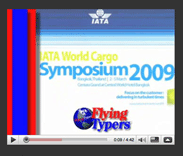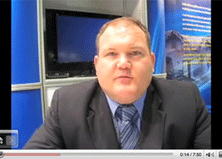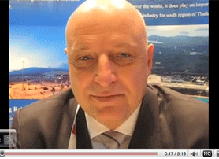

 |
 |
|
| |
||
|
Vol. 8 No. 42 WE COVER THE WORLD Wednesday April 15, 2009 |
 “We
are not talking about a crisis but there are opportunities the present global
economic situation is offering us.”
“We
are not talking about a crisis but there are opportunities the present global
economic situation is offering us.”
A statement delivered by Jo Frigger, (left, click
to view video) Chairman and CEO of the logistics provider EMO Trans USA
at the latest Dresden, Germany gathering of the worldwide EMO Network Group.
Indeed there are a number of opportunities in different corners of this globe
emphasized by some of the attendees.
Take small Djibouti at the horn of Africa, a relatively
stable and tranquil isle in the middle of a weird surrounding of surging pirate
attacks at the Gulf of Aden, civil wars and military actions.  “Indeed
Djibouti is a very active spot but a very stable country,” confirmed General
Manager Reuben Ahronee (right) of local EMO Trans partner Massida Logistics.
Which obviously stimulates business since “both Djibouti and neighboring
Ethiopia are presently having a growth rate of three to five percent,”
stated the manager. Djibouti’s crown jewel is the harbor which has developed
into a big transshipment hub in recent times.
“Indeed
Djibouti is a very active spot but a very stable country,” confirmed General
Manager Reuben Ahronee (right) of local EMO Trans partner Massida Logistics.
Which obviously stimulates business since “both Djibouti and neighboring
Ethiopia are presently having a growth rate of three to five percent,”
stated the manager. Djibouti’s crown jewel is the harbor which has developed
into a big transshipment hub in recent times.
“Nearly 80 percent of goods that arrived
by ship are sent to the Ethiopian market,” Reuben illustrated the flow
of goods. Things are even improving due to enhanced infrastructure built by
terminal operator DP World that runs the harbor.
“Ever since the new container terminal has
opened, the gate’s volumes are steadily increasing,” said manager
Reuben. Therefore, referring to Jo Frigger’s opening remarks, his message
to Dresden’s 125 EMO Trans attendees was clear: Djibouti channels ocean
freight right into Northeast Africa.
“Our qualified professionals at Massida
Logistics take care of your shipments,” he encouraged the managers of
the EMO Trans global network to consider sending their goods for this region
via Djibouti.
Another region with signs of economic recovery
is the South Pacific.
“New Zealand is a comparatively small market
that obviously is returning to growth,” said Ian Ahern, Managing Director
of EMO Trans Australia and New Zealand. This applies for some parts of Australia
too like Queensland, which has maintained a stable growth rate of 2 percent
over the last couple of years mainly because of its extensive mining and tourism
industry. The region is becoming a hot spot for EMO Trans as well, confirmed
Ian.
“Eighteen months ago we started with two
offices offering full forwarding brokerage and logistics services. In addition
to Sydney and Melbourne we meanwhile are running stations at Brisbane, Adelaide
and Perth plus Auckland in New Zealand,” Ahern told the audience.
“Strong going imports” despite the
crisis were also reported for the Russian market and those of some of the CIS
countries like Kazakhstan, Azerbaijan or Moldova by Natalia Titova, Managing
Director of Moscow-based agent STS Logistics. Especially Russia offers plenty
of opportunities for both air and ocean freight.
“International producers have invested much
money there and established manufacturing sites,” she said. A nd
more business is to come with Russia’s upcoming WTO membership. However,
there are still major obstacles for trade like the lack of warehouse space that
complies with European standards, the miserable road conditions in many parts
of the huge state, poor security standards and complicated customs regulations,
Natalia warned.
nd
more business is to come with Russia’s upcoming WTO membership. However,
there are still major obstacles for trade like the lack of warehouse space that
complies with European standards, the miserable road conditions in many parts
of the huge state, poor security standards and complicated customs regulations,
Natalia warned.
“Therefore, it’s a valid asset to
have a professional partner right on the spot that knows all about the local
business condition,” Jo Frigger lauded the ties of his EMO group with
STS Logistics. By adding that EMO Trans is also rolling up the sleeves in the
U.S. with three more stations to come in 2009, making it 31 offices in total.
“This enhances our local reach and gives
us an even better access to the market,” said Olen Wood, (pictured right
with Jo Frigger, left) President of EMO Trans USA. Further, Olen confirmed that
a number of route managers had been hired lately to push business on trade lanes
between North America and Africa, Asia, France, Germany, India, Latin America,
Middle East and some more.
“Naturally we reduce our costs as anybody
else in logistics does but at the same time we keep investing in people to intensify
sales and keep knitting our partnering network closer to enhance our global
reach,” CEO Jo Frigger emphasized.
With encouraging outcome so far.
“We are not unhappy with the results of
this year’s first quarter,” he remarked. Although the air freight
volumes went down by small margins ocean freight keeps running strong. As to
the balance of 2009, “we remain cautiously optimistic. Being a financially
strong independent company we are well prepared to weather the global downturn
in business,” Jo stated in Dresden.
Despite much uncertainty and conflicting instructions,
EMO Trans is also ready for the ongoing cargo screening issues. A number of
EMO Trans run terminals in the U.S. have already been certified as cargo screening
stations and others will follow.
Heiner Siegmund
Up
Close & Personal |
 |
 |
 |
 |
On one of its very first
commercial operations Emirates SkyCargo’s brand new B 777-200-F
touched ground at Frankfurt. Reason enough for the incoming chairman
of the board of Fraport, the airport operator, Dr. Stefan Schulte to
welcome not only the most economical all cargo aircraft in the world
but also Ram Menen, Divisional Senior Vice President Cargo, Emirates
Airlines. |
|